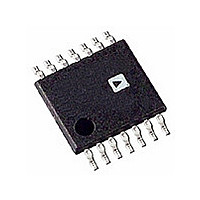AD8343ARU-REEL Analog Devices Inc, AD8343ARU-REEL Datasheet - Page 15

AD8343ARU-REEL
Manufacturer Part Number
AD8343ARU-REEL
Description
IC MIXER ACTIVE HI-IP3 14-TSSOP
Manufacturer
Analog Devices Inc
Series
AD8343r
Datasheet
1.AD8343ARUZ.pdf
(32 pages)
Specifications of AD8343ARU-REEL
Rohs Status
RoHS non-compliant
Rf Type
Cellular, WLAN
Frequency
0Hz ~ 2.5GHz
Number Of Mixers
1
Gain
7dB
Noise Figure
14dB
Secondary Attributes
Up/Down Converter
Current - Supply
60mA
Voltage - Supply
4.5 V ~ 5.5 V
Package / Case
14-TSSOP (0.173", 4.40mm Width)
Operating Temperature (min)
-40C
Operating Temperature (max)
85C
Operating Temperature Classification
Industrial
Lead Free Status / Rohs Status
Not Compliant
Available stocks
Company
Part Number
Manufacturer
Quantity
Price
CIRCUIT DESCRIPTION
The AD8343 is a mixer intended for high-intercept applications.
The signal paths are entirely differential and dc-coupled to
permit high-performance operation over a broad range of
frequencies; the block diagram (see Figure 1) shows the basic
functional blocks. The bias cell provides a PTAT (proportional
to absolute temperature) bias to the LO driver and core. The LO
driver consists of a three-stage limiting differential amplifier
that provides a very fast (almost square-wave) drive to the bases
of the core transistors.
The AD8343 core utilizes a standard architecture where the
signal inputs are directly applied to the emitters of the transis-
tors in the cell (see Figure 49 and Figure 55). The bases are
driven by the hard-limited LO signal that directs the transistors
to steer the input currents into periodically alternating pairs of
output terminals, thus providing the periodic polarity reversal
that effectively multiplies the signal by a square wave of the LO
frequency.
To illustrate this functionality, when LOIP is positive, Q1
and Q4 are turned on, and Q2 and Q3 are turned off. In this
condition, Q1 connects I
to OUTP. When LOIP is negative, the roles of the transistors
reverse, steering I
and gain are possible because, at any instant, the signal passes
through a common-base transistor amplifier pair.
Multiplication is the essence of frequency mixing; an ideal
multiplier would make an excellent mixer. The theory is
expressed in the following trigonometric identity:
sin(ω
This states that the product of two sine-wave signals of different
frequencies is a pair of sine waves at frequencies equal to the
sum and difference of the two frequencies being multiplied.
sig
PWDN
DCPL
t) × sin(ω
LOIM
LOIP
10
4
6
9
VPOS
LO
INPP
5
t) = ½[cos(ω
BIAS
DRIVER
LO
to OUTP and I
1
Figure 49. Topology
INPP
7
COMM
MIXER
CORE
to OUTM and Q4 connects I
8
Q1 Q2
11
sig
INPP
t − ω
2
14
INPM
LO
t) − cos(ω
Q3 Q4
to OUTM. Isolation
AD8343
INPM
3
sig
13
12
t + ω
OUTP
OUTM
LO
INPM
t)]
Rev. B | Page 15 of 32
Unfortunately, practical implementations of analog multipliers
generally make poor mixers because of imperfect linearity and
the added noise that invariably accompanies attempts to improve
linearity. The best mixers to date are those that use the LO
signal to periodically reverse the polarity of the input signal.
In this class of mixers, frequency conversion occurs as a
result of multiplication of the signal by a square wave at the
LO frequency. Because a square wave contains odd harmonics
in addition to the fundamental, the signal is effectively multi-
plied by each frequency component of the LO. The output of
the mixer therefore contains signals at F
5× F
arising from signal multiplication by LO harmonics falls off
with increasing harmonic order because the amplitude of a
square wave’s harmonics falls off.
An example of this process is illustrated in Figure 50. The first
pane of this figure shows an 800 MHz sinusoid intended to
represent an input signal. The second pane contains a square
wave representing an LO signal at 600 MHz which has been
hard-limited by the internal LO driver. The third pane shows
the time domain representation of the output waveform and the
fourth pane shows the frequency domain representation. The
two strongest lines in the spectrum are the sum and difference
frequencies arising from multiplication of the signal by the LOs
fundamental frequency. The weaker spectral lines are the result
of the multiplication of the signal by various harmonics of the
LO square wave.
FREQUENCY
DOMAIN
DOMAIN
LO
TIME
± F
Figure 50. Signal Switching Characteristics of the AD8343
sig
, 7×F
LO
± F
sig
, etc. The amplitude of the components
FREQUENCY
LO
± F
sig
, 3×F
SIGNAL
LOCAL
OSCILLATOR
SIG × LO
SIG × LO
AD8343
LO
± F
sig
,
















